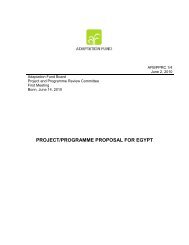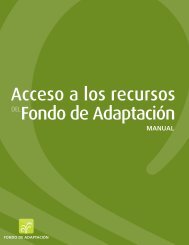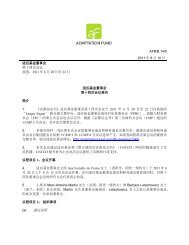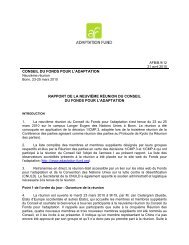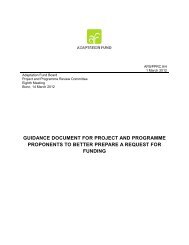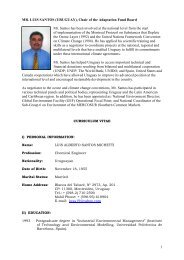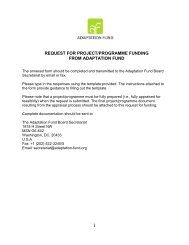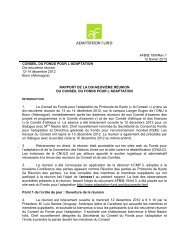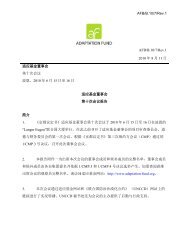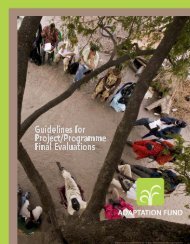Figure 2: Climate change projections for Africa (IPCC AR4, 2007)Figure 11.2Models do agree, however, on the increased unpredictability of rainfall, and this is consistentwith local observations. Figure 2 shows a prediction of overall higher temperatures and anuncertainty in rainfall variability. For West Africa the IPCC projects a range of +1.8°C to+4.7 o C for the period 2081-2100 (with a median of +3.3 o C). Temperature increases are likelyto be greater in the Northern half of Mali than in the South. 4 It is clear, however, that climatechange is expected to increase inter-annual variability and the occurrence of extremeclimatic events. It is also likely that there will be an increase in intra-seasonal variability, forexample an increase in the number of dry spells during the rainy season. 5Climate Change and Livelihood Vulnerability in MaliMali is ranked 175 in the Human Development Index out of 187 countries and categorized inthe group of countries considered of low human development with a great share of themultidimensional poor suffering deprivations in environmental services. Currently, 43% of thepopulation is living below the income poverty line (in purchasing power parity terms (PPP) of$1.25 a day). 6The Human Development Report 2011 further highlights that 59.5% of the population is livingon degraded land and only 29.2% have satisfactory water quality. The current population of15.8 million in 2011 is projected to increase to 26.8 million by 2030, severely affecting thecarrying capacity of the natural resource base, as well as increasing the ecological footprintwhich is currently 1.9 hectare per capita. The ecological footprint represents the amount ofbiologically productive land and sea area that a country requires to produce the resources itconsumes and to absorb the waste it generates. Although there is no record of the extent of4 Christensen et al. (2007). Regional Climate ions. IPCC WG II Chapter 11. The uncertainty is mainly due to theinability of most models to produce „semi-realistic‟ simulations of the Sahel drought, the lack of vegetationfeedback in the models and the fact that small changes in the Inter-Tropical Convergence Zone would producelarge changes in rainfall casts doubt on ions for precipitation5 Ebi, K., Smith, J. (2006). Mali Pilot Study: Climate Change and Agriculture In Zignasso. Final Report.Washington DC: U.S. Agency for International Development.6 UNDP (2011). Human Development Report 2011 Sustainability and Equity: A Better Future for All16
natural resource depletion, forest cover is only 10.4 % of the total land area with an annualrate of deforestation of 100.000 hectares. All these demonstrate the depletion of naturalsafety nets for livelihood security resulting in severe risks of vulnerability among the localcommunities.With a GDP per capita of US$1,185 (2009), Mali is one of the poorest countries in SubSaharan Africa. Poverty is more prevalent among the rural majority of the population (66.7%in 2010) where the majority of the people continue to derive their livelihoods from agricultureand pastoral activities. Gender inequality is extremely high with a global ranking of 143 in2011. Although females constitute 50.6% of the total population, they represent only 38.4%of the economically active population 10 . Women constitute the majority of the agriculturalshare of the economically active population with 74.9% yet represent only 3.1% of the totalagricultural landholders in Mali. This emphasizes the fact that women will bear adisproportionate share of the burden of climate change impacts on agriculture, and lackaccess to resources e.g. land rights and the capacity to cope.Mali has made some progress towards the target of the Millennium Development Goal inreducing the number of under-nourished people by 38.1% and the proportion ofundernourished in total population by 56% 9 . These gains made could however be overturnedby climate change impacts. The country is however still characterized by chronic food andnutritional insecurity, linked to endemic poverty and climate change. Malnutrition is alsosevere in Mali, being directly or indirectly responsible for more than 50 percent of the deathof children under the age of five.Climate change is expected to increase the variability and the incidence of extreme weatherevents, such as droughts, floods, intense rainfall events. Without improved planning andmanagement and particularly improved water management, climate change will destroycrops and property, and lead to greater degradation of already fragile soils. 7 Regardless ofwhether there is an increase or decrease in precipitation, increased temperatures will causegreater evapo-transpiration, which will lead to drier soils in many areas and a correspondingdecrease in water availability. 8Mali is highly dependent primarily on the agricultural sector which employs 83 percent of thepopulation, and contributes 50 percent of the GDP 9 . Following the high dependency on rainfedagriculture, the country is particularly vulnerable to climate change impacts that affectfood security. The Millet/Sorghum farming system in the Sahel is one of the most vulnerablefarming systems to drought in the world. 10 According to WPF‟s analysis, the seasonalvariability of market prices for millet, sorghum and maize is more than double as high as thatof rice.Yield models agree that crop production will decrease under most climate change scenarios.According to models, the impact of decreased water availability due to climate change willlead to a reduction of agricultural output in Mali by 15 - 20 percent. 11 The most vulnerable7 Ebi, K., Smith, J. (2006). Mali Pilot Study: Climate Change and Agriculture In Zignasso. Final Report.Washington DC: U.S. Agency for International Development.8 Danida (2008) Appréciation des impacts des changements climatiques sur les programmes de développementde la coopération Danoise au Mali. An additional factor leading to this expectation is the expected increaseddemand due to continued population and economic growth.9 Ministère de l'Equipement et des Transports, NAPA (2007)9 FAO 2011. The State of Food Insecurity in the World.10 FAO 2011. The State of Food and Agriculture 2010-11.10 Hyman, G. S. Fujisaka, P. Jones, S. Wood , M. Carmen de Vicente, J. Dixon (2008). Strategic approaches totargeting technology generation: Assessing the coincidence of poverty and drought-prone production. AgriculturalSystems 98: 50-6111 Butt et all. 2003 and World Conference on Disaster Reduction. 199417



